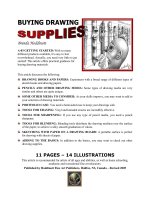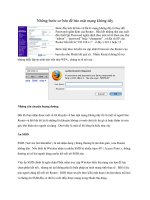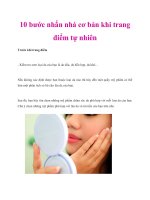GETTING STARTED - Bắt đầu những bước cơ bản
Bạn đang xem bản rút gọn của tài liệu. Xem và tải ngay bản đầy đủ của tài liệu tại đây (872.86 KB, 11 trang )
BUYING DRAWING
Brenda Hoddinott
A-03 GETTING STARTED: With so many
different products available, it's easy to feel
overwhelmed. Actually, you need very little to get
started! This article offers practical guidance for
buying drawing materials.
This article discusses the following:
DRAWING BOOKS AND PAPERS: Experiment with a broad range of different types of
sketch books and drawing papers.
PENCILS AND OTHER DRAWING MEDIA: Some types of drawing media are very
similar and others are quite unique.
SOME OTHER MEDIA TO CONSIDER: As your skills improve, you may want to add to
your selection of drawing materials.
PORTFOLIO CASE: You need a hard-sided case to keep your drawings safe.
TOOLS FOR ERASING: Vinyl and kneaded erasers are incredibly effective.
TOOLS FOR SHARPENING: If you use any type of pencil media, you need a pencil
sharpener.
TOOLS FOR BLENDING: Blending tools distribute the drawing medium over the surface
of the paper, to achieve a silky smooth graduation of values.
SKETCHING WITH PAPER ON A DRAWING BOARD: A portable surface is perfect
for drawing with sheets of paper.
ADDING TO THE BASICS: In addition to the basics, you may want to check out other
drawing supplies.
11 PAGES – 14 ILLUSTRATIONS
This article is recommended for artists of all ages and abilities, as well as home schooling,
academic and recreational fine art educators.
Published by Hoddinott Fine Art Publishers, Halifax, NS, Canada – Revised 2005
Copyright to all articles, images, text, projects, lessons and exercises within this drawing class belong to Brenda Hoddinott and
may not be reproduced or used for any commercial purposes whatsoever without the written permission of Brenda Hoddinott.
Web site or
2
INTRODUCTION
With so many different products available, it's easy to feel overwhelmed. Actually, you need
very little to get started! This article offers practical guidance for buying drawing materials.
You could probably find a few pencils and sheets of paper lying around your home. However,
keep in mind that they may be designed for purposes other than drawing. You need to begin your
drawing journey with professional materials that are designed specifically for artists. As with
most activities, the better your tools the happier you’ll be with the outcomes.
ILLUSTRATION 03-01
Even though you may be
able to economize on
some drawing materials,
don’t try to scrimp and
save money on the three
most important items -
sketchbooks, pencils, and
erasers. Plan to go
shopping at a reputable
art store and buy the best
quality you can
comfortably afford.
Time to make your
shopping list! The old
expression “You get what
you pay for” definitely
applies to art supplies.
DRAWING BOOKS AND PAPERS
Treat yourself to the luxury of experimenting with a broad range of different types of sketch
books and drawing papers. Check out various art supply and stationary stores, and some
department stores and purchase the best quality that you can afford. Make sure the actual paper is
acid-free, or your drawings will deteriorate quickly.
DRAWING BOOKS (SOMETIMES CALLED SKETCHBOOKS)
Even though soft-covered sketchbooks are usually less expensive, drawings may easily become
crumpled and damaged. A hard cover sketchbook is much more durable, and protects your
treasured masterpieces from being ruined. If you happen to like drawing outside, away from a
table, you’ll really come to appreciate the hard covers as a solid surface on which to draw.
Choose a size that is easy to transport when you travel. Stay away from sketchbooks under 9 by
12 inches or your drawing options for composition and subjects will be too limited.
Copyright to all articles, images, text, projects, lessons and exercises within this drawing class belong to Brenda Hoddinott and
may not be reproduced or used for any commercial purposes whatsoever without the written permission of Brenda Hoddinott.
Web site or
3
ILLUSTRATION 03-02
DRAWING PAPERS
Drawing papers come in oodles of colors, textures, and sizes. Go to a good art supply store,
purchase several different types, and then try sketching on each until you discover your favorites.
Tooth refers to the surface texture of paper and can range from silky smooth to very course. The
more tooth a paper has, the rougher it feels to the touch. Some artists like smooth paper, and
others prefer rougher, more heavily textured paper. Consider the qualities of the following three
types of paper:
ILLUSTRATION 03-03
This close-up of shading was rendered with a 6B pencil on
smooth, fine-tooth paper. Fine tooth paper often feels velvety
smooth to the touch and is perfect for rendering fine textures
with hatching, crosshatching and/or squirkling.
A word to the wise: stay away from papers with a really glossy
surface! If the paper’s surface is too smooth, the graphite
simply won’t stick very well, and it’s darn near impossible to
render medium and dark values.
Copyright to all articles, images, text, projects, lessons and exercises within this drawing class belong to Brenda Hoddinott and
may not be reproduced or used for any commercial purposes whatsoever without the written permission of Brenda Hoddinott.
Web site or
4
ILLUSTRATION 03-04
Shading with a 6B pencil on medium-tooth sketchbook paper
created this wonderful delicate texture. Medium tooth papers
are ideal for most portrait drawings and work beautifully for
rendering a full range of values from light to dark. The surface
allows you to easily create diverse textures. Many artists prefer
a medium tooth drawing surface in that it’s somewhere in
between smooth and rough.
ILLUSTRATION 03-05
The peaks and crevices of rough watercolor paper helped
create this textured shading. Coarse, highly textured paper
holds graphite very well. Some really great textures appear
when the peaks of the paper grab the graphite and some of the
crevices show through as white.
PENCILS AND OTHER DRAWING MEDIA
Artists have been drawing with graphite for centuries and even today it remains the most popular
drawing medium. It has withstood the test of time for permanence, and lends itself beautifully to
all styles of drawing.
Some other types of drawing media are very similar and others are quite unique. For example, a
drawing done with charcoal looks completely different than one done in graphite or pen. Media
such as colored pencils, conté crayons, and pastels present you with the challenge of combining
values with colors.
ILLUSTRATION 03-06
Copyright to all articles, images, text, projects, lessons and exercises within this drawing class belong to Brenda Hoddinott and
may not be reproduced or used for any commercial purposes whatsoever without the written permission of Brenda Hoddinott.
Web site or
5
GRAPHITE (SOMETIMES CALLED LEAD PENCIL)
Pencils are your most important drawing tools, so buy the highest quality you can afford.
Inexpensive graphite may work well for writing, but are often poor quality and can sometimes
scratch your drawing paper instead of going on smoothly. A big ugly scratch mark right smack
dab in the middle of smooth shading can be incredibly annoying and frustrating.
Graphite comes in various grades and beginners only need a few different pencils. Generally
speaking, H pencils work beautifully for light and middle values, and B pencils are best for
middle and dark values. When you use a combination of both H and B pencils you can easily
create a full range of values in your drawings. Choose a selection of both H and B pencils, such
as 2H, HB, 2B, 4B, and 6B. 2H is the lightest (hardest), and the 6B is the darkest (softest).
ILLUSTRATION 03-07
6H 5H 4H 3H 2H H F HB
ILLUSTRATION 03-08
B 2B 3B 4B 5B 6B 7B 8B
Mechanical pencils are a fantastic alternative to pencils that need to be constantly sharpened.
They can hold various grades of graphite from very hard to soft and come in different sizes, such
as 0.3, 0.5, 0.7 and 0.9. A 0.3 mm pencil allows you to render very detailed drawings, a 0.5 mm
pencil is great for regular drawings and 0.7 or 0.9 mm mechanical pencils are ideal for sketching
loosely or drawing on a large surface (or both).









